Inventory Management and Supply Chain Research Report Analysis
VerifiedAdded on 2023/03/30
|11
|2598
|71
Report
AI Summary
This research report provides a detailed analysis of inventory management within the context of the supply chain. It begins with an executive summary, table of contents, and introduction, followed by an extensive literature review that covers the background, conceptual information, and importance of inventory management, including how it prevents stockouts and ensures accurate record keeping. The report examines the interaction between inventory management and the supply chain, current trends in inventory management, and a discussion of how organizations can deal with excess inventory. The report uses systematic analysis to examine existing research and data, highlighting the impact of technology and the importance of harmonizing demand and production. The findings emphasize the close relationship between the supply chain and inventory management, offering insights into the challenges and opportunities in modern business operations. The report concludes with a discussion on the implications of the research findings and potential future directions.
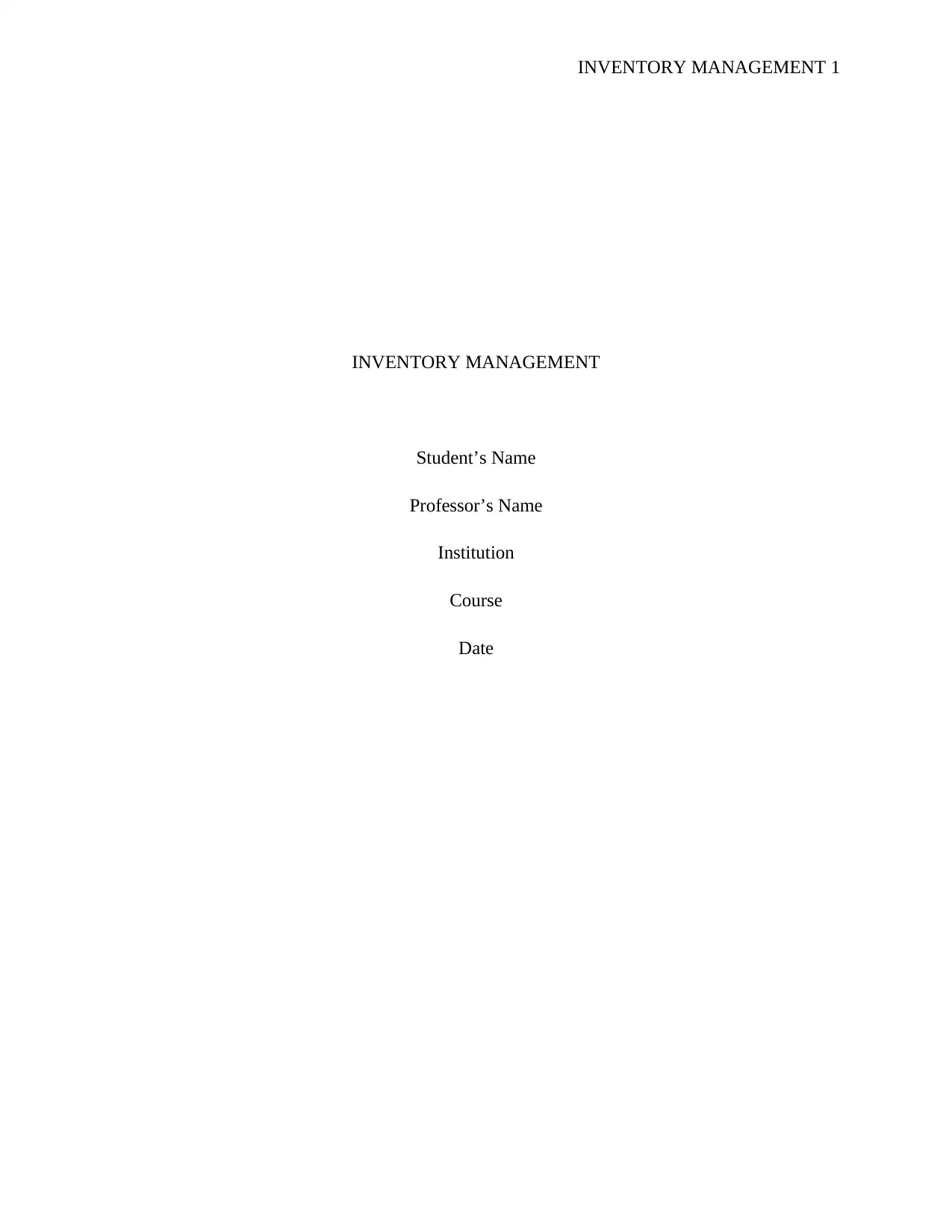
INVENTORY MANAGEMENT 1
INVENTORY MANAGEMENT
Student’s Name
Professor’s Name
Institution
Course
Date
INVENTORY MANAGEMENT
Student’s Name
Professor’s Name
Institution
Course
Date
Paraphrase This Document
Need a fresh take? Get an instant paraphrase of this document with our AI Paraphraser
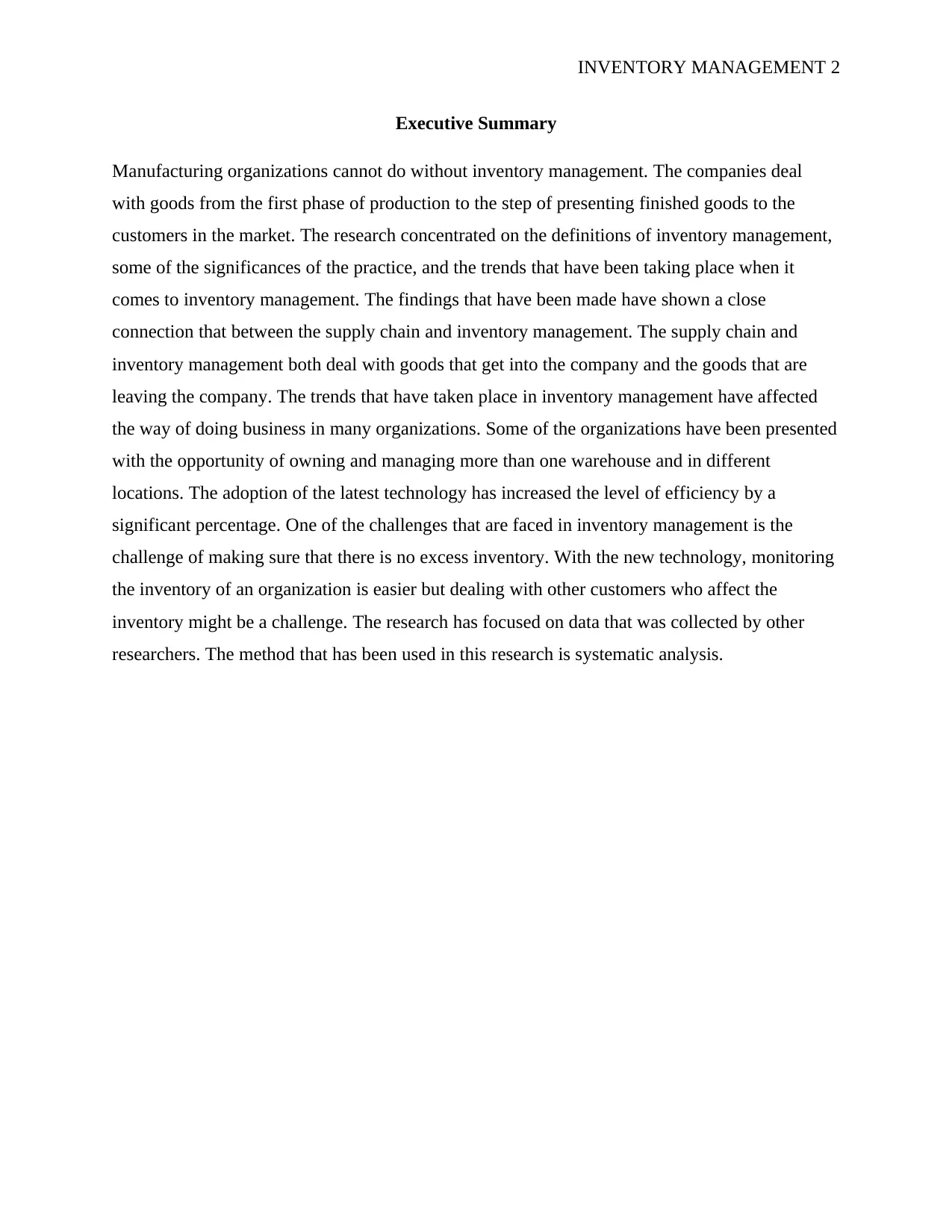
INVENTORY MANAGEMENT 2
Executive Summary
Manufacturing organizations cannot do without inventory management. The companies deal
with goods from the first phase of production to the step of presenting finished goods to the
customers in the market. The research concentrated on the definitions of inventory management,
some of the significances of the practice, and the trends that have been taking place when it
comes to inventory management. The findings that have been made have shown a close
connection that between the supply chain and inventory management. The supply chain and
inventory management both deal with goods that get into the company and the goods that are
leaving the company. The trends that have taken place in inventory management have affected
the way of doing business in many organizations. Some of the organizations have been presented
with the opportunity of owning and managing more than one warehouse and in different
locations. The adoption of the latest technology has increased the level of efficiency by a
significant percentage. One of the challenges that are faced in inventory management is the
challenge of making sure that there is no excess inventory. With the new technology, monitoring
the inventory of an organization is easier but dealing with other customers who affect the
inventory might be a challenge. The research has focused on data that was collected by other
researchers. The method that has been used in this research is systematic analysis.
Executive Summary
Manufacturing organizations cannot do without inventory management. The companies deal
with goods from the first phase of production to the step of presenting finished goods to the
customers in the market. The research concentrated on the definitions of inventory management,
some of the significances of the practice, and the trends that have been taking place when it
comes to inventory management. The findings that have been made have shown a close
connection that between the supply chain and inventory management. The supply chain and
inventory management both deal with goods that get into the company and the goods that are
leaving the company. The trends that have taken place in inventory management have affected
the way of doing business in many organizations. Some of the organizations have been presented
with the opportunity of owning and managing more than one warehouse and in different
locations. The adoption of the latest technology has increased the level of efficiency by a
significant percentage. One of the challenges that are faced in inventory management is the
challenge of making sure that there is no excess inventory. With the new technology, monitoring
the inventory of an organization is easier but dealing with other customers who affect the
inventory might be a challenge. The research has focused on data that was collected by other
researchers. The method that has been used in this research is systematic analysis.
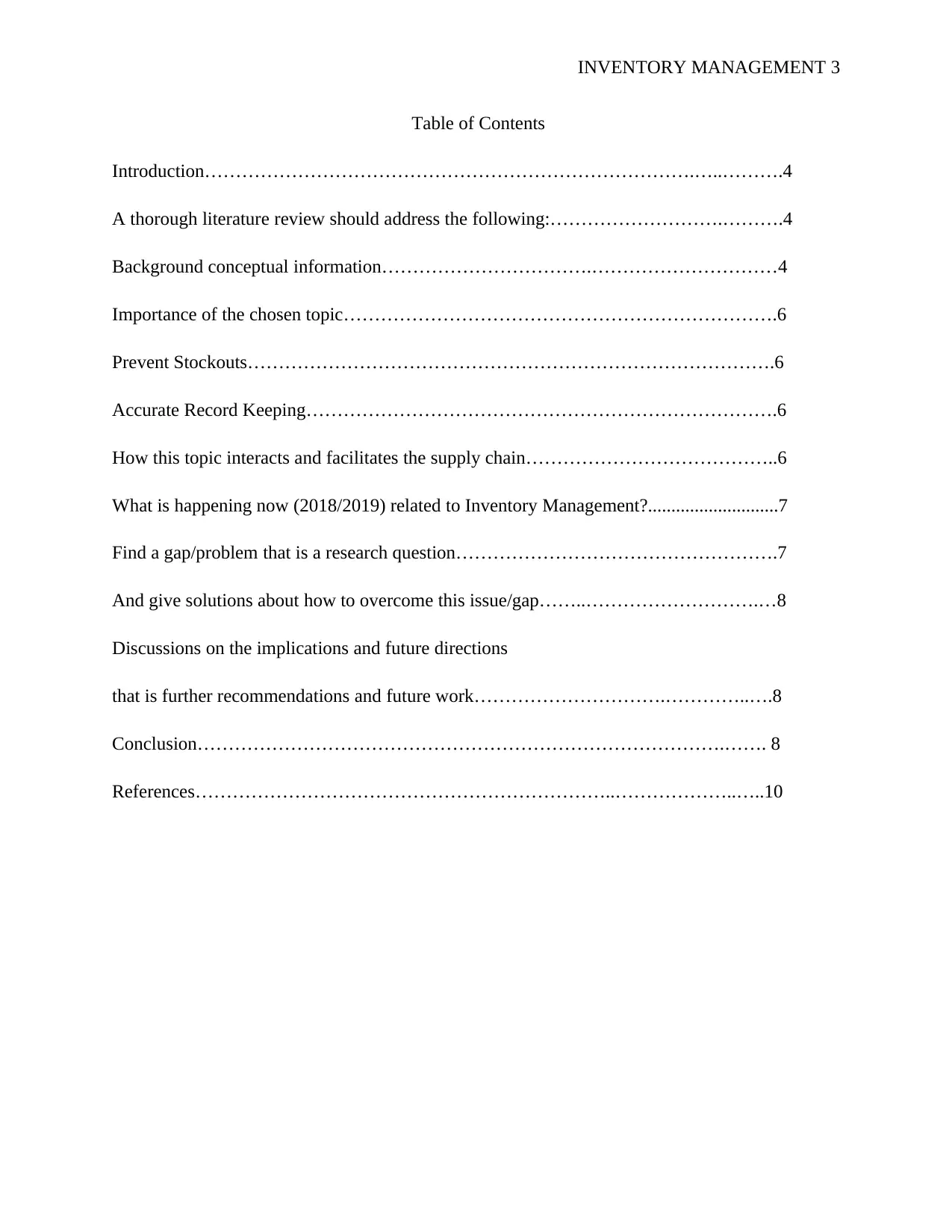
INVENTORY MANAGEMENT 3
Table of Contents
Introduction…………………………………………………………………….…..……….4
A thorough literature review should address the following:……………………….……….4
Background conceptual information…………………………….…………………………4
Importance of the chosen topic…………………………………………………………….6
Prevent Stockouts………………………………………………………………………….6
Accurate Record Keeping………………………………………………………………….6
How this topic interacts and facilitates the supply chain…………………………………..6
What is happening now (2018/2019) related to Inventory Management?............................7
Find a gap/problem that is a research question…………………………………………….7
And give solutions about how to overcome this issue/gap……..……………………….…8
Discussions on the implications and future directions
that is further recommendations and future work………………………….…………..….8
Conclusion………………………………………………………………………….……. 8
References…………………………………………………………..………………..…..10
Table of Contents
Introduction…………………………………………………………………….…..……….4
A thorough literature review should address the following:……………………….……….4
Background conceptual information…………………………….…………………………4
Importance of the chosen topic…………………………………………………………….6
Prevent Stockouts………………………………………………………………………….6
Accurate Record Keeping………………………………………………………………….6
How this topic interacts and facilitates the supply chain…………………………………..6
What is happening now (2018/2019) related to Inventory Management?............................7
Find a gap/problem that is a research question…………………………………………….7
And give solutions about how to overcome this issue/gap……..……………………….…8
Discussions on the implications and future directions
that is further recommendations and future work………………………….…………..….8
Conclusion………………………………………………………………………….……. 8
References…………………………………………………………..………………..…..10
⊘ This is a preview!⊘
Do you want full access?
Subscribe today to unlock all pages.

Trusted by 1+ million students worldwide
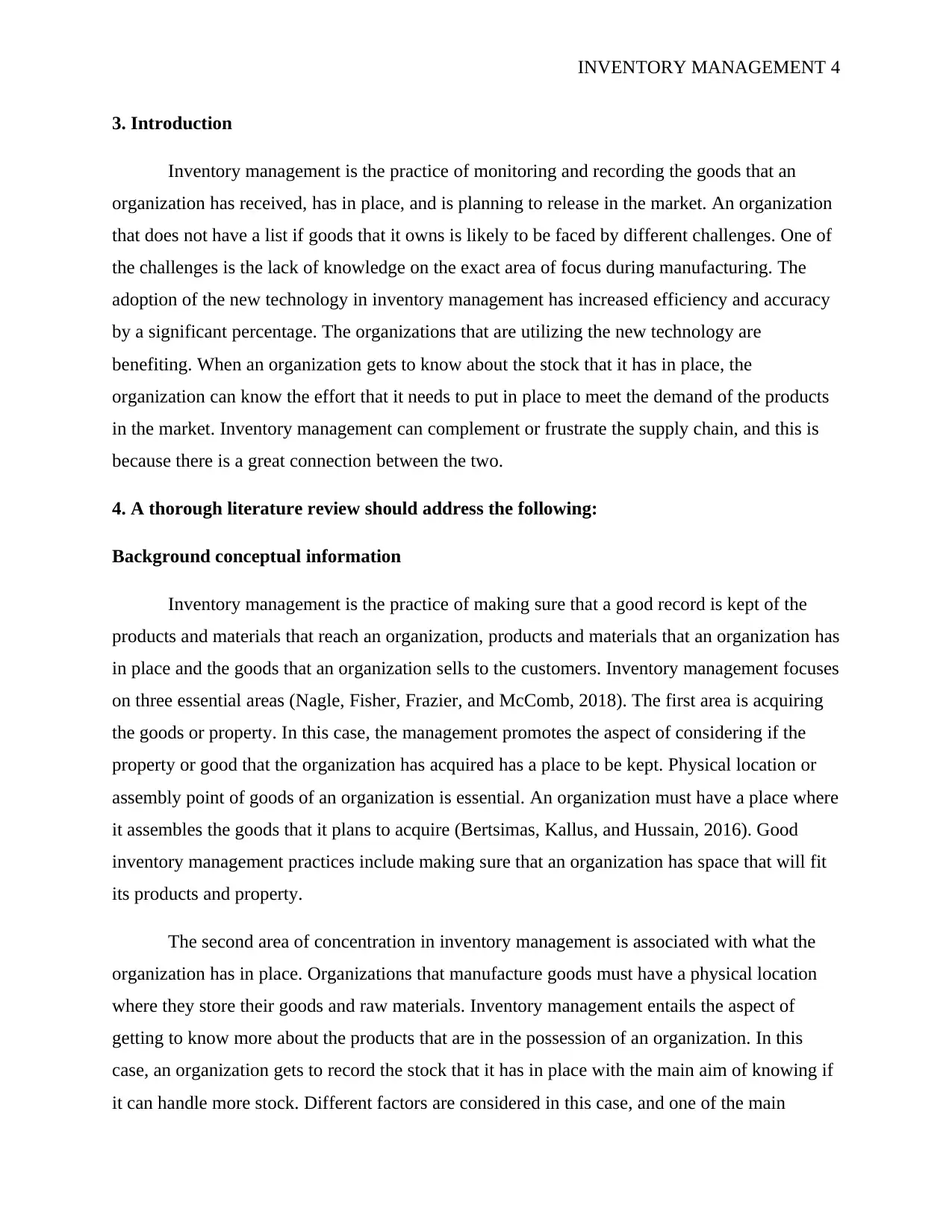
INVENTORY MANAGEMENT 4
3. Introduction
Inventory management is the practice of monitoring and recording the goods that an
organization has received, has in place, and is planning to release in the market. An organization
that does not have a list if goods that it owns is likely to be faced by different challenges. One of
the challenges is the lack of knowledge on the exact area of focus during manufacturing. The
adoption of the new technology in inventory management has increased efficiency and accuracy
by a significant percentage. The organizations that are utilizing the new technology are
benefiting. When an organization gets to know about the stock that it has in place, the
organization can know the effort that it needs to put in place to meet the demand of the products
in the market. Inventory management can complement or frustrate the supply chain, and this is
because there is a great connection between the two.
4. A thorough literature review should address the following:
Background conceptual information
Inventory management is the practice of making sure that a good record is kept of the
products and materials that reach an organization, products and materials that an organization has
in place and the goods that an organization sells to the customers. Inventory management focuses
on three essential areas (Nagle, Fisher, Frazier, and McComb, 2018). The first area is acquiring
the goods or property. In this case, the management promotes the aspect of considering if the
property or good that the organization has acquired has a place to be kept. Physical location or
assembly point of goods of an organization is essential. An organization must have a place where
it assembles the goods that it plans to acquire (Bertsimas, Kallus, and Hussain, 2016). Good
inventory management practices include making sure that an organization has space that will fit
its products and property.
The second area of concentration in inventory management is associated with what the
organization has in place. Organizations that manufacture goods must have a physical location
where they store their goods and raw materials. Inventory management entails the aspect of
getting to know more about the products that are in the possession of an organization. In this
case, an organization gets to record the stock that it has in place with the main aim of knowing if
it can handle more stock. Different factors are considered in this case, and one of the main
3. Introduction
Inventory management is the practice of monitoring and recording the goods that an
organization has received, has in place, and is planning to release in the market. An organization
that does not have a list if goods that it owns is likely to be faced by different challenges. One of
the challenges is the lack of knowledge on the exact area of focus during manufacturing. The
adoption of the new technology in inventory management has increased efficiency and accuracy
by a significant percentage. The organizations that are utilizing the new technology are
benefiting. When an organization gets to know about the stock that it has in place, the
organization can know the effort that it needs to put in place to meet the demand of the products
in the market. Inventory management can complement or frustrate the supply chain, and this is
because there is a great connection between the two.
4. A thorough literature review should address the following:
Background conceptual information
Inventory management is the practice of making sure that a good record is kept of the
products and materials that reach an organization, products and materials that an organization has
in place and the goods that an organization sells to the customers. Inventory management focuses
on three essential areas (Nagle, Fisher, Frazier, and McComb, 2018). The first area is acquiring
the goods or property. In this case, the management promotes the aspect of considering if the
property or good that the organization has acquired has a place to be kept. Physical location or
assembly point of goods of an organization is essential. An organization must have a place where
it assembles the goods that it plans to acquire (Bertsimas, Kallus, and Hussain, 2016). Good
inventory management practices include making sure that an organization has space that will fit
its products and property.
The second area of concentration in inventory management is associated with what the
organization has in place. Organizations that manufacture goods must have a physical location
where they store their goods and raw materials. Inventory management entails the aspect of
getting to know more about the products that are in the possession of an organization. In this
case, an organization gets to record the stock that it has in place with the main aim of knowing if
it can handle more stock. Different factors are considered in this case, and one of the main
Paraphrase This Document
Need a fresh take? Get an instant paraphrase of this document with our AI Paraphraser
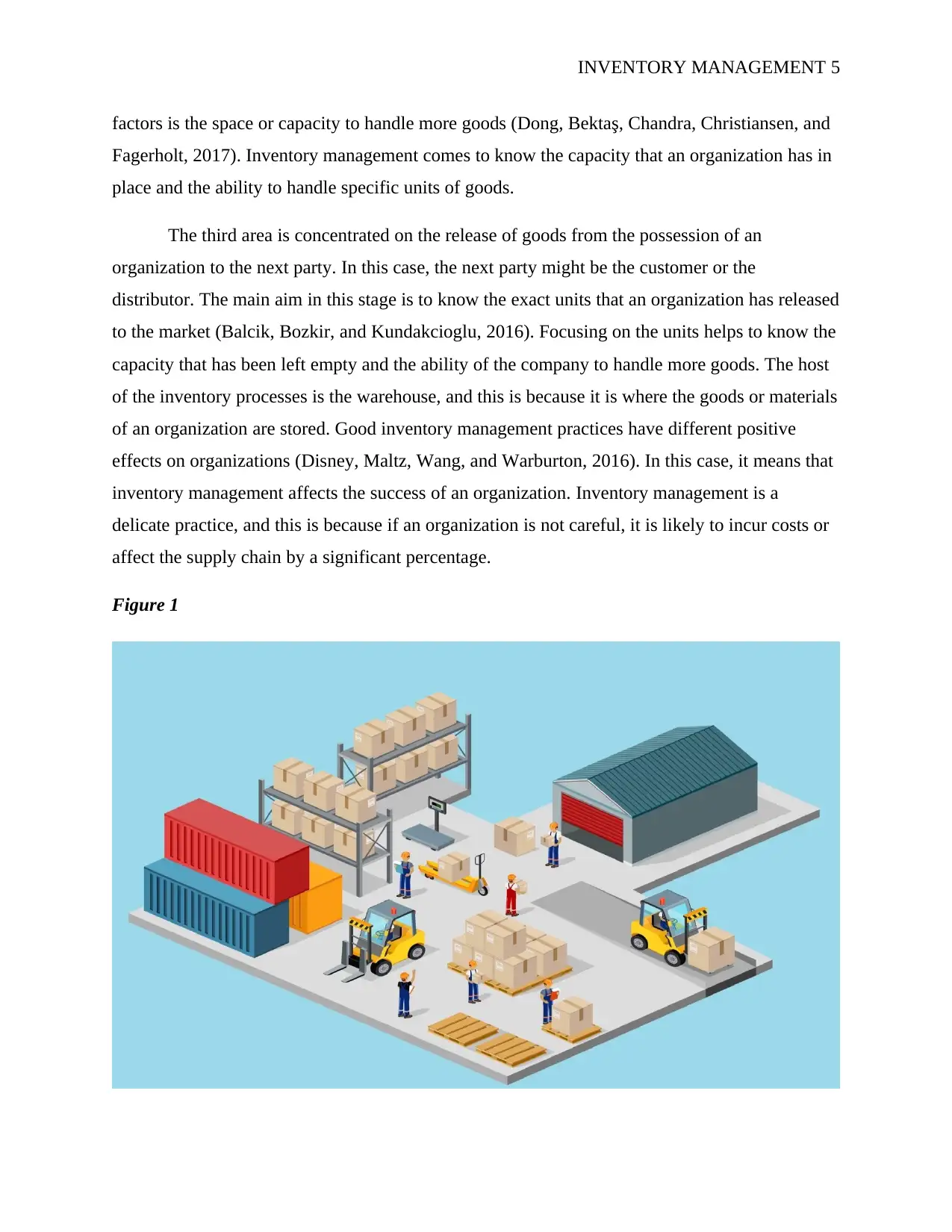
INVENTORY MANAGEMENT 5
factors is the space or capacity to handle more goods (Dong, Bektaş, Chandra, Christiansen, and
Fagerholt, 2017). Inventory management comes to know the capacity that an organization has in
place and the ability to handle specific units of goods.
The third area is concentrated on the release of goods from the possession of an
organization to the next party. In this case, the next party might be the customer or the
distributor. The main aim in this stage is to know the exact units that an organization has released
to the market (Balcik, Bozkir, and Kundakcioglu, 2016). Focusing on the units helps to know the
capacity that has been left empty and the ability of the company to handle more goods. The host
of the inventory processes is the warehouse, and this is because it is where the goods or materials
of an organization are stored. Good inventory management practices have different positive
effects on organizations (Disney, Maltz, Wang, and Warburton, 2016). In this case, it means that
inventory management affects the success of an organization. Inventory management is a
delicate practice, and this is because if an organization is not careful, it is likely to incur costs or
affect the supply chain by a significant percentage.
Figure 1
factors is the space or capacity to handle more goods (Dong, Bektaş, Chandra, Christiansen, and
Fagerholt, 2017). Inventory management comes to know the capacity that an organization has in
place and the ability to handle specific units of goods.
The third area is concentrated on the release of goods from the possession of an
organization to the next party. In this case, the next party might be the customer or the
distributor. The main aim in this stage is to know the exact units that an organization has released
to the market (Balcik, Bozkir, and Kundakcioglu, 2016). Focusing on the units helps to know the
capacity that has been left empty and the ability of the company to handle more goods. The host
of the inventory processes is the warehouse, and this is because it is where the goods or materials
of an organization are stored. Good inventory management practices have different positive
effects on organizations (Disney, Maltz, Wang, and Warburton, 2016). In this case, it means that
inventory management affects the success of an organization. Inventory management is a
delicate practice, and this is because if an organization is not careful, it is likely to incur costs or
affect the supply chain by a significant percentage.
Figure 1
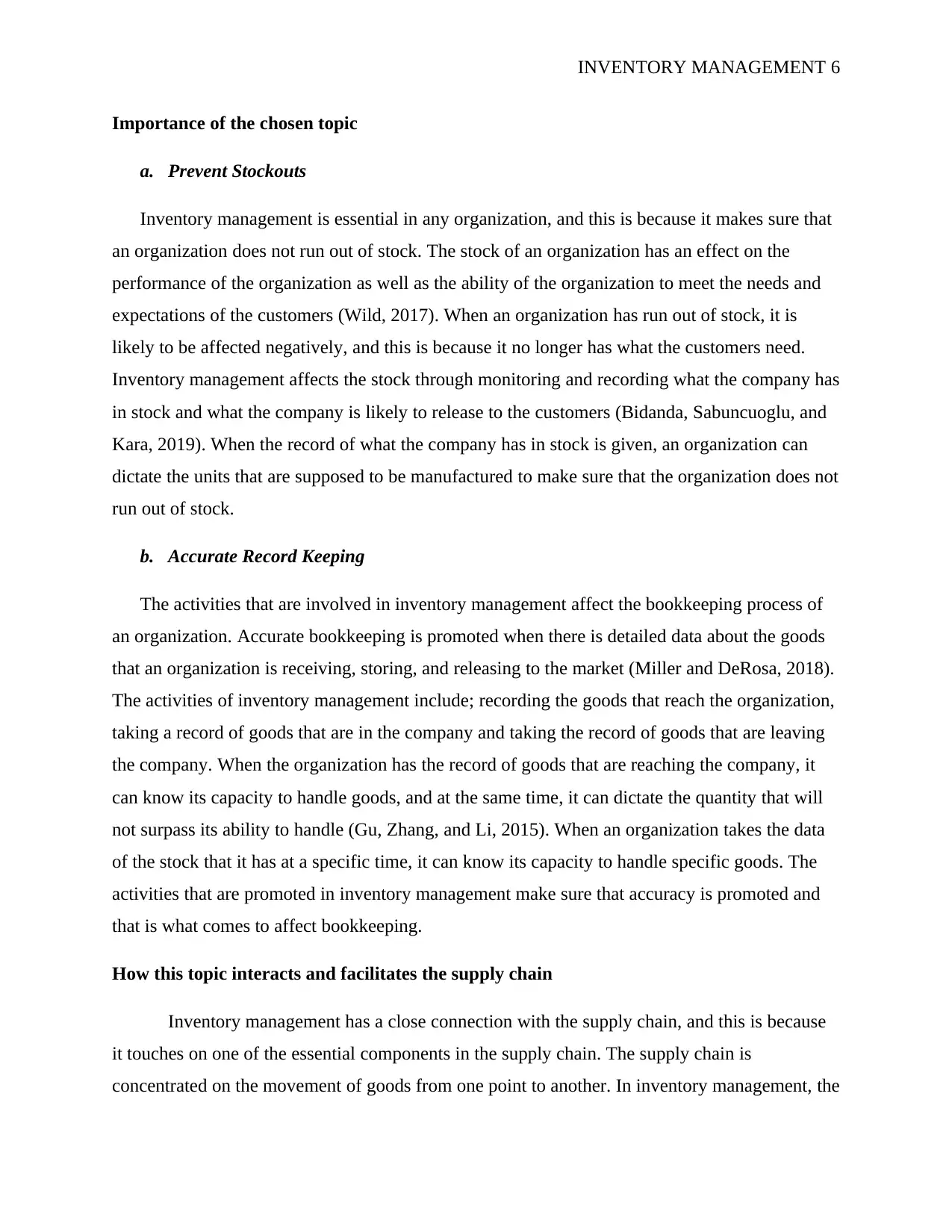
INVENTORY MANAGEMENT 6
Importance of the chosen topic
a. Prevent Stockouts
Inventory management is essential in any organization, and this is because it makes sure that
an organization does not run out of stock. The stock of an organization has an effect on the
performance of the organization as well as the ability of the organization to meet the needs and
expectations of the customers (Wild, 2017). When an organization has run out of stock, it is
likely to be affected negatively, and this is because it no longer has what the customers need.
Inventory management affects the stock through monitoring and recording what the company has
in stock and what the company is likely to release to the customers (Bidanda, Sabuncuoglu, and
Kara, 2019). When the record of what the company has in stock is given, an organization can
dictate the units that are supposed to be manufactured to make sure that the organization does not
run out of stock.
b. Accurate Record Keeping
The activities that are involved in inventory management affect the bookkeeping process of
an organization. Accurate bookkeeping is promoted when there is detailed data about the goods
that an organization is receiving, storing, and releasing to the market (Miller and DeRosa, 2018).
The activities of inventory management include; recording the goods that reach the organization,
taking a record of goods that are in the company and taking the record of goods that are leaving
the company. When the organization has the record of goods that are reaching the company, it
can know its capacity to handle goods, and at the same time, it can dictate the quantity that will
not surpass its ability to handle (Gu, Zhang, and Li, 2015). When an organization takes the data
of the stock that it has at a specific time, it can know its capacity to handle specific goods. The
activities that are promoted in inventory management make sure that accuracy is promoted and
that is what comes to affect bookkeeping.
How this topic interacts and facilitates the supply chain
Inventory management has a close connection with the supply chain, and this is because
it touches on one of the essential components in the supply chain. The supply chain is
concentrated on the movement of goods from one point to another. In inventory management, the
Importance of the chosen topic
a. Prevent Stockouts
Inventory management is essential in any organization, and this is because it makes sure that
an organization does not run out of stock. The stock of an organization has an effect on the
performance of the organization as well as the ability of the organization to meet the needs and
expectations of the customers (Wild, 2017). When an organization has run out of stock, it is
likely to be affected negatively, and this is because it no longer has what the customers need.
Inventory management affects the stock through monitoring and recording what the company has
in stock and what the company is likely to release to the customers (Bidanda, Sabuncuoglu, and
Kara, 2019). When the record of what the company has in stock is given, an organization can
dictate the units that are supposed to be manufactured to make sure that the organization does not
run out of stock.
b. Accurate Record Keeping
The activities that are involved in inventory management affect the bookkeeping process of
an organization. Accurate bookkeeping is promoted when there is detailed data about the goods
that an organization is receiving, storing, and releasing to the market (Miller and DeRosa, 2018).
The activities of inventory management include; recording the goods that reach the organization,
taking a record of goods that are in the company and taking the record of goods that are leaving
the company. When the organization has the record of goods that are reaching the company, it
can know its capacity to handle goods, and at the same time, it can dictate the quantity that will
not surpass its ability to handle (Gu, Zhang, and Li, 2015). When an organization takes the data
of the stock that it has at a specific time, it can know its capacity to handle specific goods. The
activities that are promoted in inventory management make sure that accuracy is promoted and
that is what comes to affect bookkeeping.
How this topic interacts and facilitates the supply chain
Inventory management has a close connection with the supply chain, and this is because
it touches on one of the essential components in the supply chain. The supply chain is
concentrated on the movement of goods from one point to another. In inventory management, the
⊘ This is a preview!⊘
Do you want full access?
Subscribe today to unlock all pages.

Trusted by 1+ million students worldwide
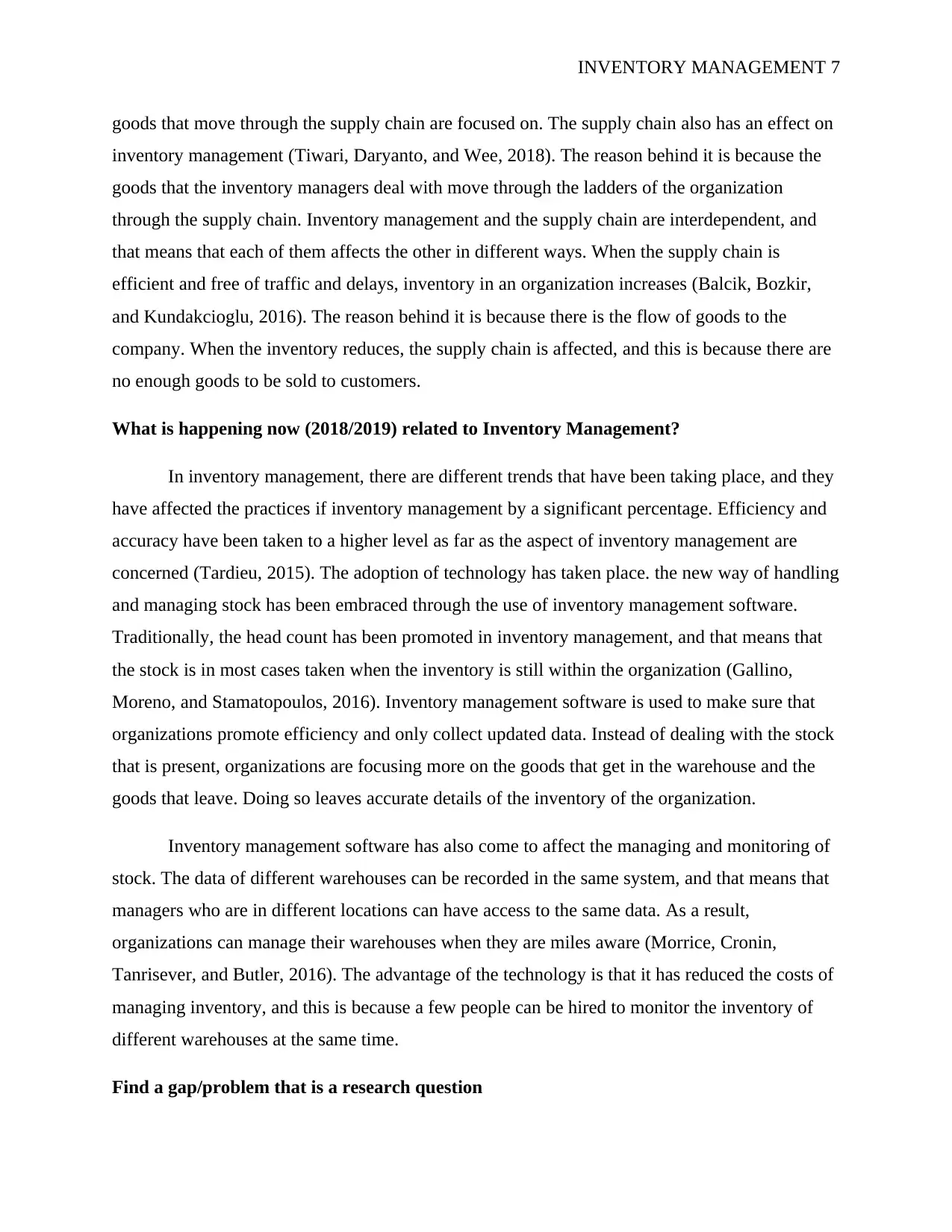
INVENTORY MANAGEMENT 7
goods that move through the supply chain are focused on. The supply chain also has an effect on
inventory management (Tiwari, Daryanto, and Wee, 2018). The reason behind it is because the
goods that the inventory managers deal with move through the ladders of the organization
through the supply chain. Inventory management and the supply chain are interdependent, and
that means that each of them affects the other in different ways. When the supply chain is
efficient and free of traffic and delays, inventory in an organization increases (Balcik, Bozkir,
and Kundakcioglu, 2016). The reason behind it is because there is the flow of goods to the
company. When the inventory reduces, the supply chain is affected, and this is because there are
no enough goods to be sold to customers.
What is happening now (2018/2019) related to Inventory Management?
In inventory management, there are different trends that have been taking place, and they
have affected the practices if inventory management by a significant percentage. Efficiency and
accuracy have been taken to a higher level as far as the aspect of inventory management are
concerned (Tardieu, 2015). The adoption of technology has taken place. the new way of handling
and managing stock has been embraced through the use of inventory management software.
Traditionally, the head count has been promoted in inventory management, and that means that
the stock is in most cases taken when the inventory is still within the organization (Gallino,
Moreno, and Stamatopoulos, 2016). Inventory management software is used to make sure that
organizations promote efficiency and only collect updated data. Instead of dealing with the stock
that is present, organizations are focusing more on the goods that get in the warehouse and the
goods that leave. Doing so leaves accurate details of the inventory of the organization.
Inventory management software has also come to affect the managing and monitoring of
stock. The data of different warehouses can be recorded in the same system, and that means that
managers who are in different locations can have access to the same data. As a result,
organizations can manage their warehouses when they are miles aware (Morrice, Cronin,
Tanrisever, and Butler, 2016). The advantage of the technology is that it has reduced the costs of
managing inventory, and this is because a few people can be hired to monitor the inventory of
different warehouses at the same time.
Find a gap/problem that is a research question
goods that move through the supply chain are focused on. The supply chain also has an effect on
inventory management (Tiwari, Daryanto, and Wee, 2018). The reason behind it is because the
goods that the inventory managers deal with move through the ladders of the organization
through the supply chain. Inventory management and the supply chain are interdependent, and
that means that each of them affects the other in different ways. When the supply chain is
efficient and free of traffic and delays, inventory in an organization increases (Balcik, Bozkir,
and Kundakcioglu, 2016). The reason behind it is because there is the flow of goods to the
company. When the inventory reduces, the supply chain is affected, and this is because there are
no enough goods to be sold to customers.
What is happening now (2018/2019) related to Inventory Management?
In inventory management, there are different trends that have been taking place, and they
have affected the practices if inventory management by a significant percentage. Efficiency and
accuracy have been taken to a higher level as far as the aspect of inventory management are
concerned (Tardieu, 2015). The adoption of technology has taken place. the new way of handling
and managing stock has been embraced through the use of inventory management software.
Traditionally, the head count has been promoted in inventory management, and that means that
the stock is in most cases taken when the inventory is still within the organization (Gallino,
Moreno, and Stamatopoulos, 2016). Inventory management software is used to make sure that
organizations promote efficiency and only collect updated data. Instead of dealing with the stock
that is present, organizations are focusing more on the goods that get in the warehouse and the
goods that leave. Doing so leaves accurate details of the inventory of the organization.
Inventory management software has also come to affect the managing and monitoring of
stock. The data of different warehouses can be recorded in the same system, and that means that
managers who are in different locations can have access to the same data. As a result,
organizations can manage their warehouses when they are miles aware (Morrice, Cronin,
Tanrisever, and Butler, 2016). The advantage of the technology is that it has reduced the costs of
managing inventory, and this is because a few people can be hired to monitor the inventory of
different warehouses at the same time.
Find a gap/problem that is a research question
Paraphrase This Document
Need a fresh take? Get an instant paraphrase of this document with our AI Paraphraser
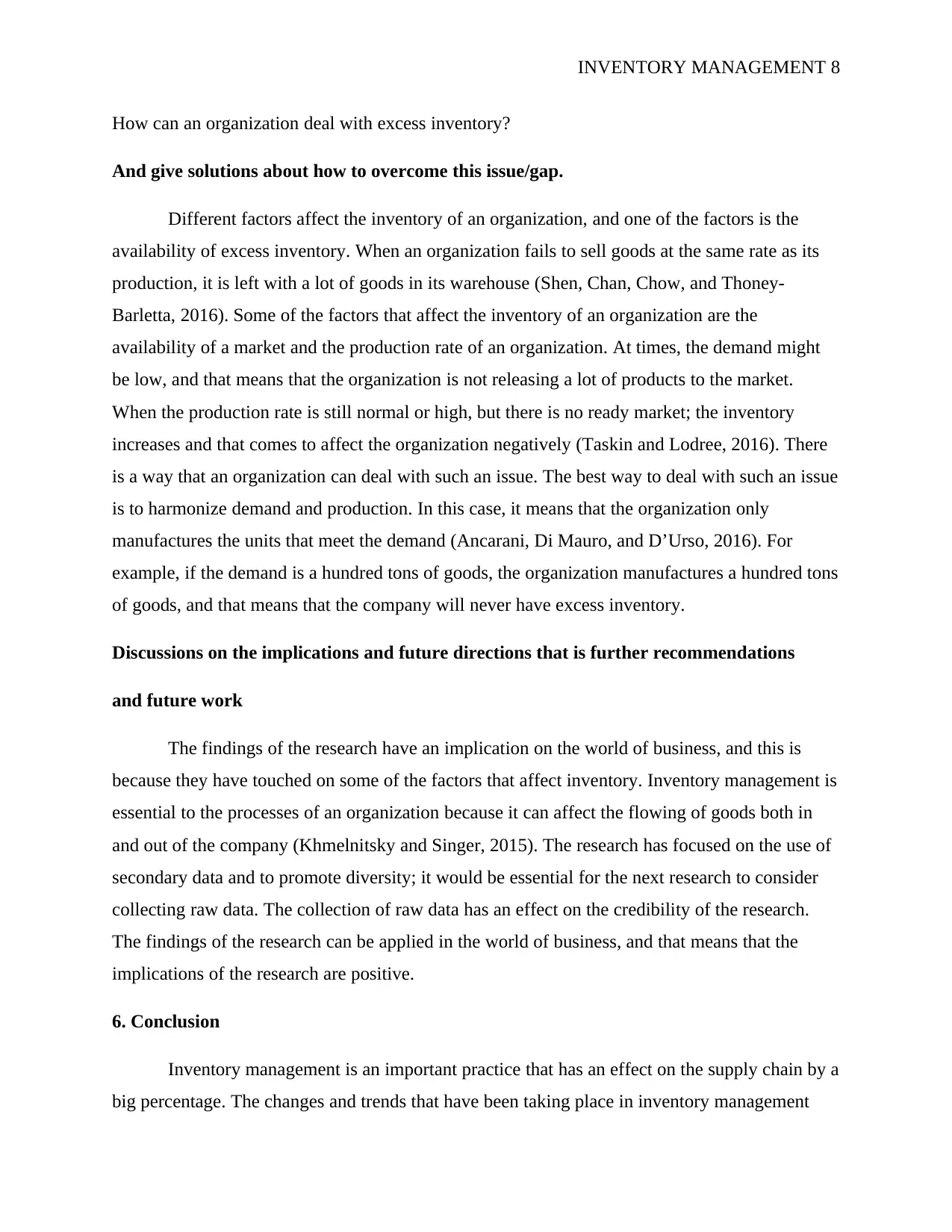
INVENTORY MANAGEMENT 8
How can an organization deal with excess inventory?
And give solutions about how to overcome this issue/gap.
Different factors affect the inventory of an organization, and one of the factors is the
availability of excess inventory. When an organization fails to sell goods at the same rate as its
production, it is left with a lot of goods in its warehouse (Shen, Chan, Chow, and Thoney-
Barletta, 2016). Some of the factors that affect the inventory of an organization are the
availability of a market and the production rate of an organization. At times, the demand might
be low, and that means that the organization is not releasing a lot of products to the market.
When the production rate is still normal or high, but there is no ready market; the inventory
increases and that comes to affect the organization negatively (Taskin and Lodree, 2016). There
is a way that an organization can deal with such an issue. The best way to deal with such an issue
is to harmonize demand and production. In this case, it means that the organization only
manufactures the units that meet the demand (Ancarani, Di Mauro, and D’Urso, 2016). For
example, if the demand is a hundred tons of goods, the organization manufactures a hundred tons
of goods, and that means that the company will never have excess inventory.
Discussions on the implications and future directions that is further recommendations
and future work
The findings of the research have an implication on the world of business, and this is
because they have touched on some of the factors that affect inventory. Inventory management is
essential to the processes of an organization because it can affect the flowing of goods both in
and out of the company (Khmelnitsky and Singer, 2015). The research has focused on the use of
secondary data and to promote diversity; it would be essential for the next research to consider
collecting raw data. The collection of raw data has an effect on the credibility of the research.
The findings of the research can be applied in the world of business, and that means that the
implications of the research are positive.
6. Conclusion
Inventory management is an important practice that has an effect on the supply chain by a
big percentage. The changes and trends that have been taking place in inventory management
How can an organization deal with excess inventory?
And give solutions about how to overcome this issue/gap.
Different factors affect the inventory of an organization, and one of the factors is the
availability of excess inventory. When an organization fails to sell goods at the same rate as its
production, it is left with a lot of goods in its warehouse (Shen, Chan, Chow, and Thoney-
Barletta, 2016). Some of the factors that affect the inventory of an organization are the
availability of a market and the production rate of an organization. At times, the demand might
be low, and that means that the organization is not releasing a lot of products to the market.
When the production rate is still normal or high, but there is no ready market; the inventory
increases and that comes to affect the organization negatively (Taskin and Lodree, 2016). There
is a way that an organization can deal with such an issue. The best way to deal with such an issue
is to harmonize demand and production. In this case, it means that the organization only
manufactures the units that meet the demand (Ancarani, Di Mauro, and D’Urso, 2016). For
example, if the demand is a hundred tons of goods, the organization manufactures a hundred tons
of goods, and that means that the company will never have excess inventory.
Discussions on the implications and future directions that is further recommendations
and future work
The findings of the research have an implication on the world of business, and this is
because they have touched on some of the factors that affect inventory. Inventory management is
essential to the processes of an organization because it can affect the flowing of goods both in
and out of the company (Khmelnitsky and Singer, 2015). The research has focused on the use of
secondary data and to promote diversity; it would be essential for the next research to consider
collecting raw data. The collection of raw data has an effect on the credibility of the research.
The findings of the research can be applied in the world of business, and that means that the
implications of the research are positive.
6. Conclusion
Inventory management is an important practice that has an effect on the supply chain by a
big percentage. The changes and trends that have been taking place in inventory management
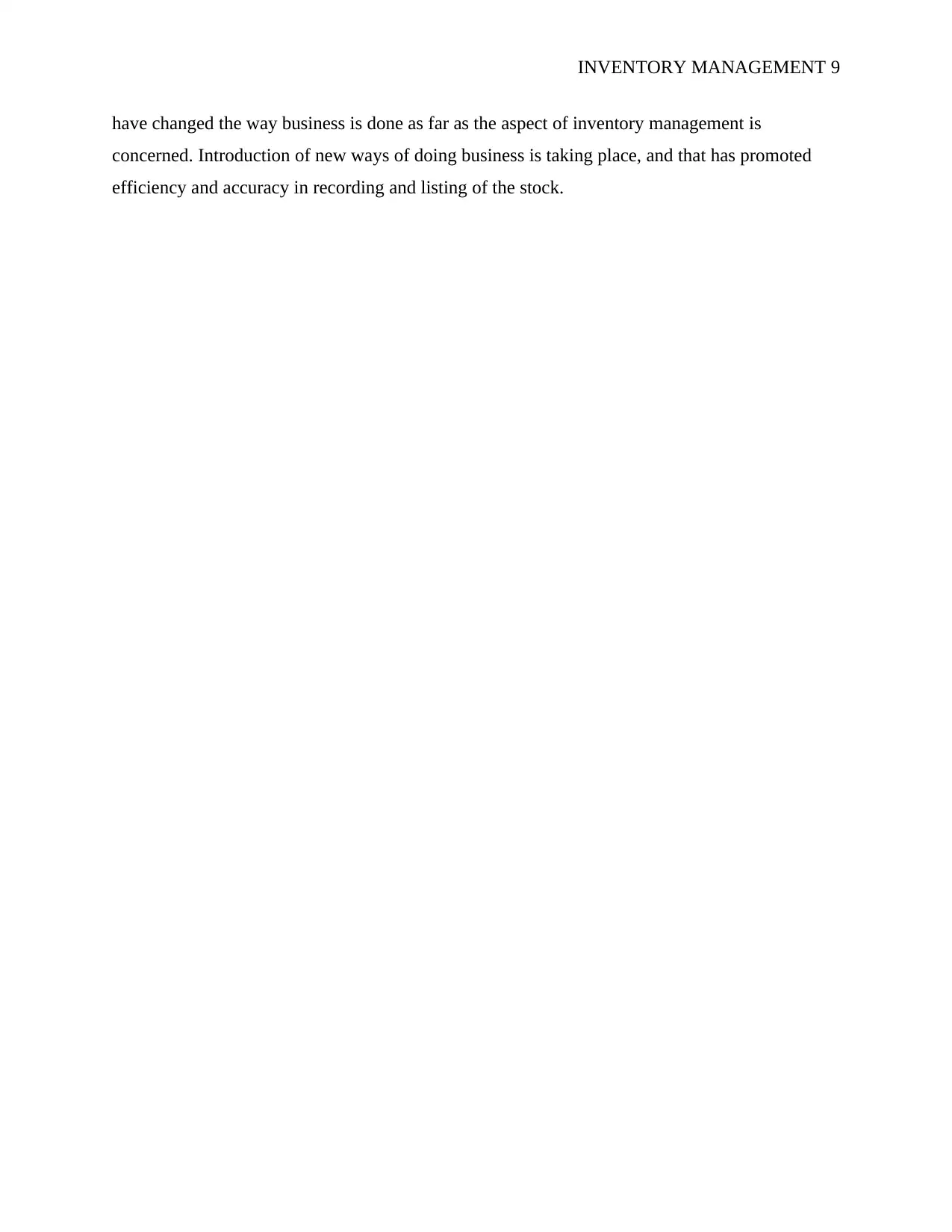
INVENTORY MANAGEMENT 9
have changed the way business is done as far as the aspect of inventory management is
concerned. Introduction of new ways of doing business is taking place, and that has promoted
efficiency and accuracy in recording and listing of the stock.
have changed the way business is done as far as the aspect of inventory management is
concerned. Introduction of new ways of doing business is taking place, and that has promoted
efficiency and accuracy in recording and listing of the stock.
⊘ This is a preview!⊘
Do you want full access?
Subscribe today to unlock all pages.

Trusted by 1+ million students worldwide
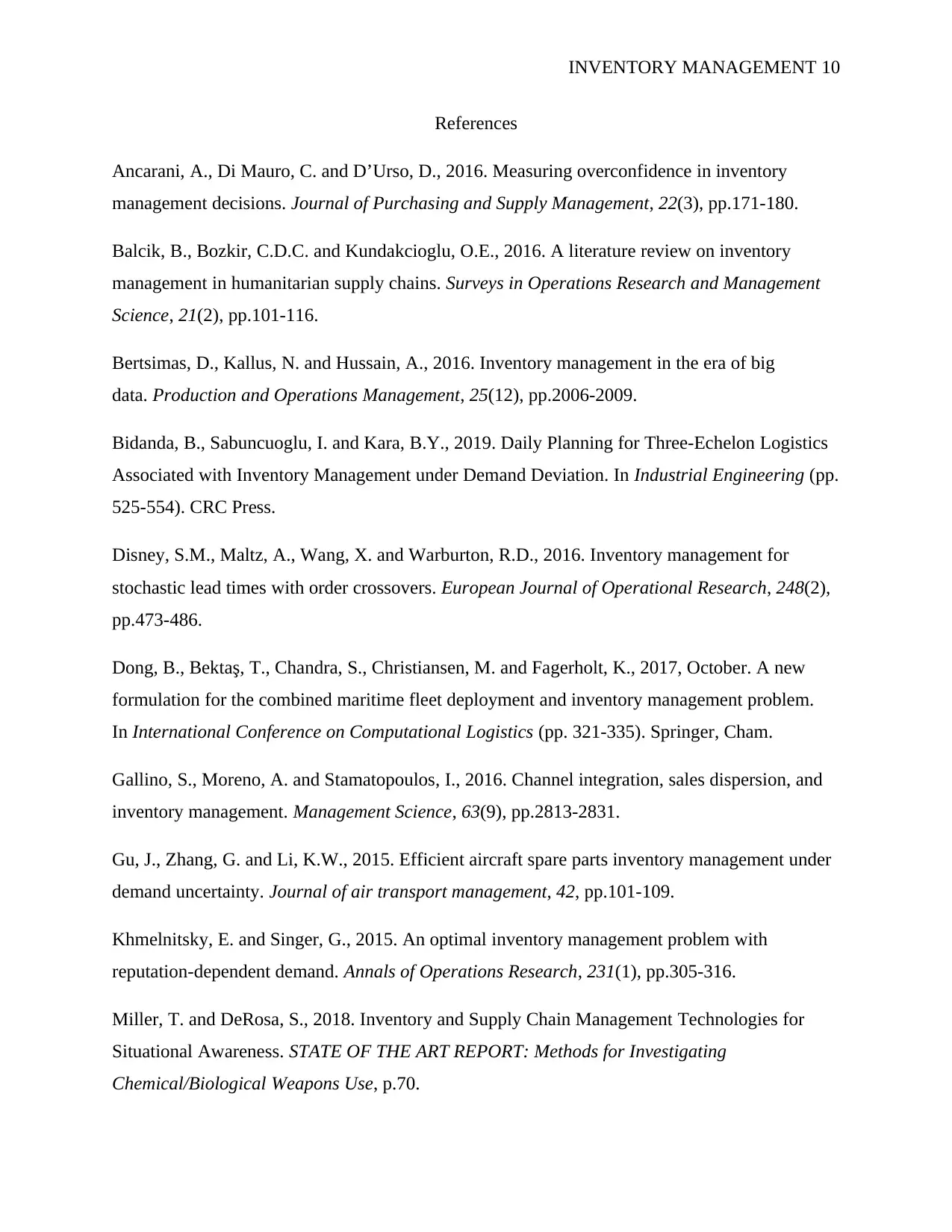
INVENTORY MANAGEMENT 10
References
Ancarani, A., Di Mauro, C. and D’Urso, D., 2016. Measuring overconfidence in inventory
management decisions. Journal of Purchasing and Supply Management, 22(3), pp.171-180.
Balcik, B., Bozkir, C.D.C. and Kundakcioglu, O.E., 2016. A literature review on inventory
management in humanitarian supply chains. Surveys in Operations Research and Management
Science, 21(2), pp.101-116.
Bertsimas, D., Kallus, N. and Hussain, A., 2016. Inventory management in the era of big
data. Production and Operations Management, 25(12), pp.2006-2009.
Bidanda, B., Sabuncuoglu, I. and Kara, B.Y., 2019. Daily Planning for Three-Echelon Logistics
Associated with Inventory Management under Demand Deviation. In Industrial Engineering (pp.
525-554). CRC Press.
Disney, S.M., Maltz, A., Wang, X. and Warburton, R.D., 2016. Inventory management for
stochastic lead times with order crossovers. European Journal of Operational Research, 248(2),
pp.473-486.
Dong, B., Bektaş, T., Chandra, S., Christiansen, M. and Fagerholt, K., 2017, October. A new
formulation for the combined maritime fleet deployment and inventory management problem.
In International Conference on Computational Logistics (pp. 321-335). Springer, Cham.
Gallino, S., Moreno, A. and Stamatopoulos, I., 2016. Channel integration, sales dispersion, and
inventory management. Management Science, 63(9), pp.2813-2831.
Gu, J., Zhang, G. and Li, K.W., 2015. Efficient aircraft spare parts inventory management under
demand uncertainty. Journal of air transport management, 42, pp.101-109.
Khmelnitsky, E. and Singer, G., 2015. An optimal inventory management problem with
reputation-dependent demand. Annals of Operations Research, 231(1), pp.305-316.
Miller, T. and DeRosa, S., 2018. Inventory and Supply Chain Management Technologies for
Situational Awareness. STATE OF THE ART REPORT: Methods for Investigating
Chemical/Biological Weapons Use, p.70.
References
Ancarani, A., Di Mauro, C. and D’Urso, D., 2016. Measuring overconfidence in inventory
management decisions. Journal of Purchasing and Supply Management, 22(3), pp.171-180.
Balcik, B., Bozkir, C.D.C. and Kundakcioglu, O.E., 2016. A literature review on inventory
management in humanitarian supply chains. Surveys in Operations Research and Management
Science, 21(2), pp.101-116.
Bertsimas, D., Kallus, N. and Hussain, A., 2016. Inventory management in the era of big
data. Production and Operations Management, 25(12), pp.2006-2009.
Bidanda, B., Sabuncuoglu, I. and Kara, B.Y., 2019. Daily Planning for Three-Echelon Logistics
Associated with Inventory Management under Demand Deviation. In Industrial Engineering (pp.
525-554). CRC Press.
Disney, S.M., Maltz, A., Wang, X. and Warburton, R.D., 2016. Inventory management for
stochastic lead times with order crossovers. European Journal of Operational Research, 248(2),
pp.473-486.
Dong, B., Bektaş, T., Chandra, S., Christiansen, M. and Fagerholt, K., 2017, October. A new
formulation for the combined maritime fleet deployment and inventory management problem.
In International Conference on Computational Logistics (pp. 321-335). Springer, Cham.
Gallino, S., Moreno, A. and Stamatopoulos, I., 2016. Channel integration, sales dispersion, and
inventory management. Management Science, 63(9), pp.2813-2831.
Gu, J., Zhang, G. and Li, K.W., 2015. Efficient aircraft spare parts inventory management under
demand uncertainty. Journal of air transport management, 42, pp.101-109.
Khmelnitsky, E. and Singer, G., 2015. An optimal inventory management problem with
reputation-dependent demand. Annals of Operations Research, 231(1), pp.305-316.
Miller, T. and DeRosa, S., 2018. Inventory and Supply Chain Management Technologies for
Situational Awareness. STATE OF THE ART REPORT: Methods for Investigating
Chemical/Biological Weapons Use, p.70.
Paraphrase This Document
Need a fresh take? Get an instant paraphrase of this document with our AI Paraphraser
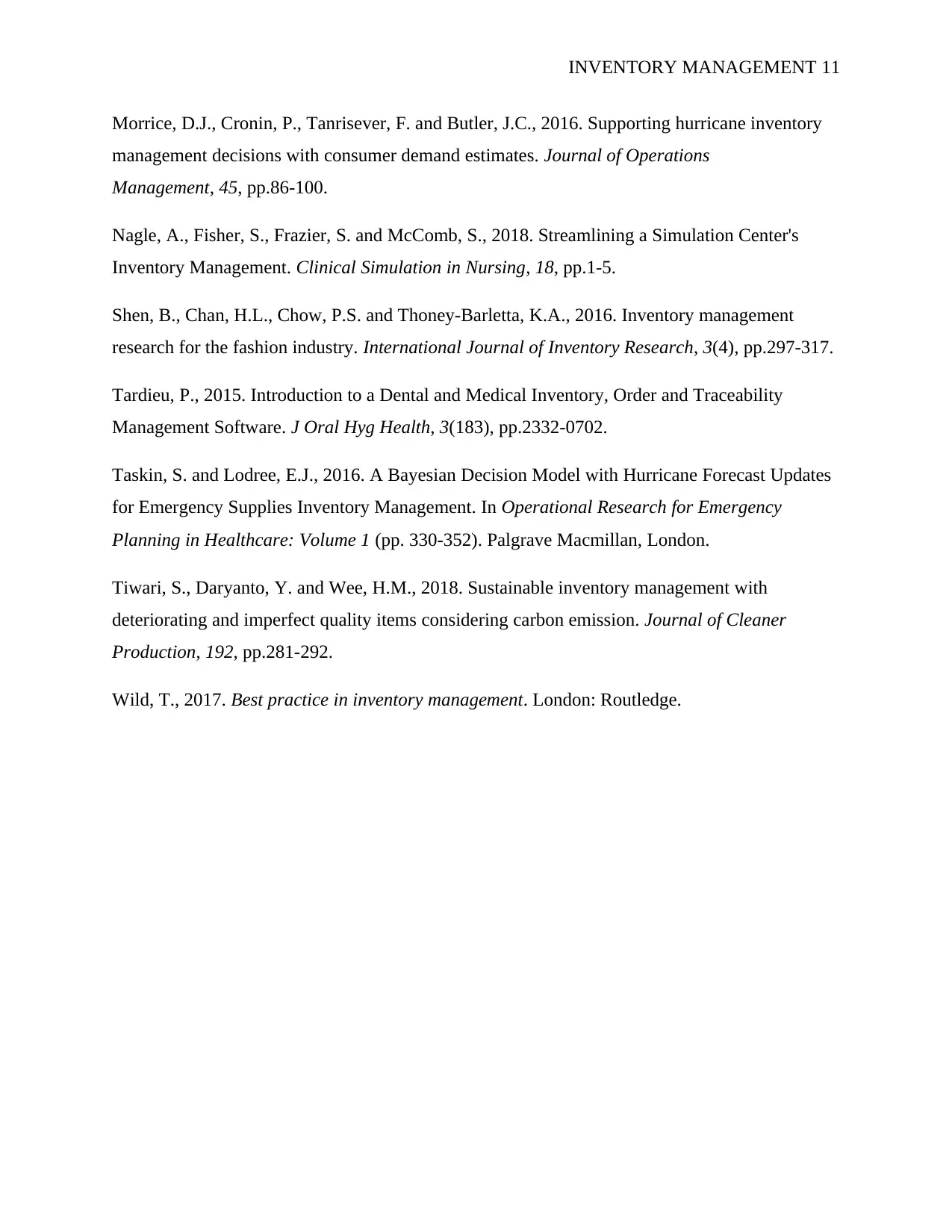
INVENTORY MANAGEMENT 11
Morrice, D.J., Cronin, P., Tanrisever, F. and Butler, J.C., 2016. Supporting hurricane inventory
management decisions with consumer demand estimates. Journal of Operations
Management, 45, pp.86-100.
Nagle, A., Fisher, S., Frazier, S. and McComb, S., 2018. Streamlining a Simulation Center's
Inventory Management. Clinical Simulation in Nursing, 18, pp.1-5.
Shen, B., Chan, H.L., Chow, P.S. and Thoney-Barletta, K.A., 2016. Inventory management
research for the fashion industry. International Journal of Inventory Research, 3(4), pp.297-317.
Tardieu, P., 2015. Introduction to a Dental and Medical Inventory, Order and Traceability
Management Software. J Oral Hyg Health, 3(183), pp.2332-0702.
Taskin, S. and Lodree, E.J., 2016. A Bayesian Decision Model with Hurricane Forecast Updates
for Emergency Supplies Inventory Management. In Operational Research for Emergency
Planning in Healthcare: Volume 1 (pp. 330-352). Palgrave Macmillan, London.
Tiwari, S., Daryanto, Y. and Wee, H.M., 2018. Sustainable inventory management with
deteriorating and imperfect quality items considering carbon emission. Journal of Cleaner
Production, 192, pp.281-292.
Wild, T., 2017. Best practice in inventory management. London: Routledge.
Morrice, D.J., Cronin, P., Tanrisever, F. and Butler, J.C., 2016. Supporting hurricane inventory
management decisions with consumer demand estimates. Journal of Operations
Management, 45, pp.86-100.
Nagle, A., Fisher, S., Frazier, S. and McComb, S., 2018. Streamlining a Simulation Center's
Inventory Management. Clinical Simulation in Nursing, 18, pp.1-5.
Shen, B., Chan, H.L., Chow, P.S. and Thoney-Barletta, K.A., 2016. Inventory management
research for the fashion industry. International Journal of Inventory Research, 3(4), pp.297-317.
Tardieu, P., 2015. Introduction to a Dental and Medical Inventory, Order and Traceability
Management Software. J Oral Hyg Health, 3(183), pp.2332-0702.
Taskin, S. and Lodree, E.J., 2016. A Bayesian Decision Model with Hurricane Forecast Updates
for Emergency Supplies Inventory Management. In Operational Research for Emergency
Planning in Healthcare: Volume 1 (pp. 330-352). Palgrave Macmillan, London.
Tiwari, S., Daryanto, Y. and Wee, H.M., 2018. Sustainable inventory management with
deteriorating and imperfect quality items considering carbon emission. Journal of Cleaner
Production, 192, pp.281-292.
Wild, T., 2017. Best practice in inventory management. London: Routledge.
1 out of 11
Related Documents
Your All-in-One AI-Powered Toolkit for Academic Success.
+13062052269
info@desklib.com
Available 24*7 on WhatsApp / Email
![[object Object]](/_next/static/media/star-bottom.7253800d.svg)
Unlock your academic potential
Copyright © 2020–2025 A2Z Services. All Rights Reserved. Developed and managed by ZUCOL.





